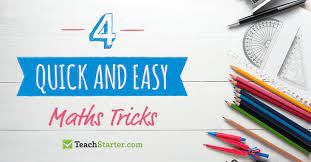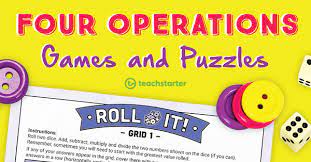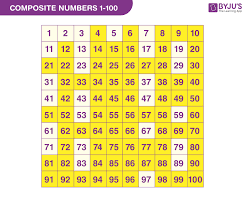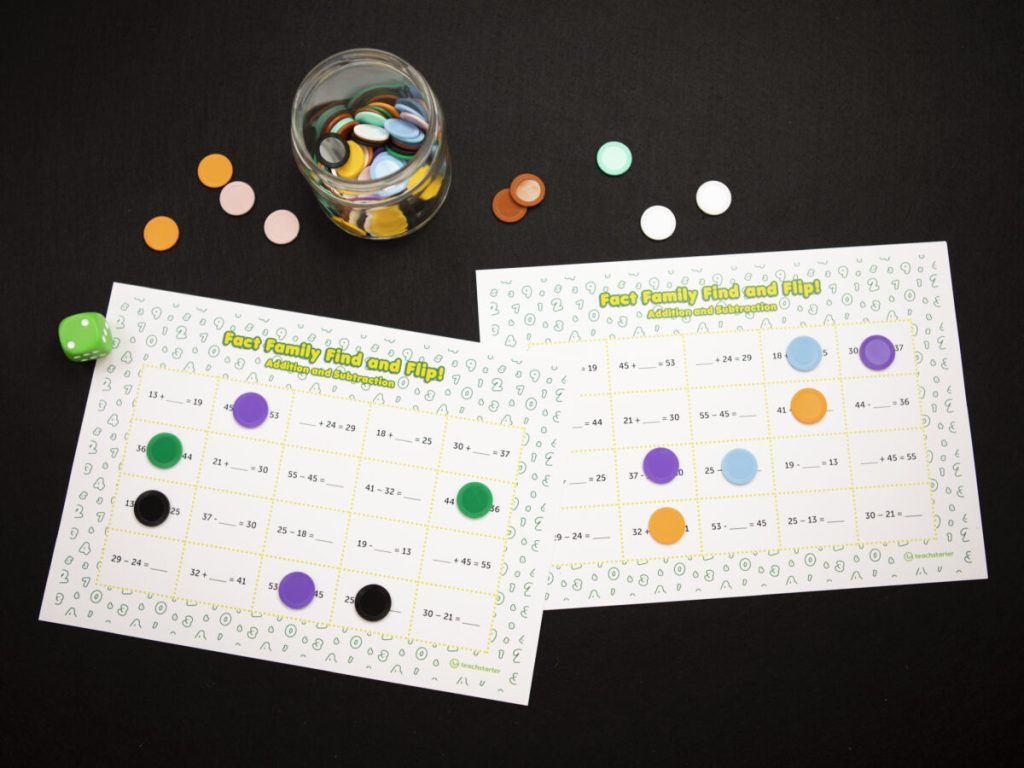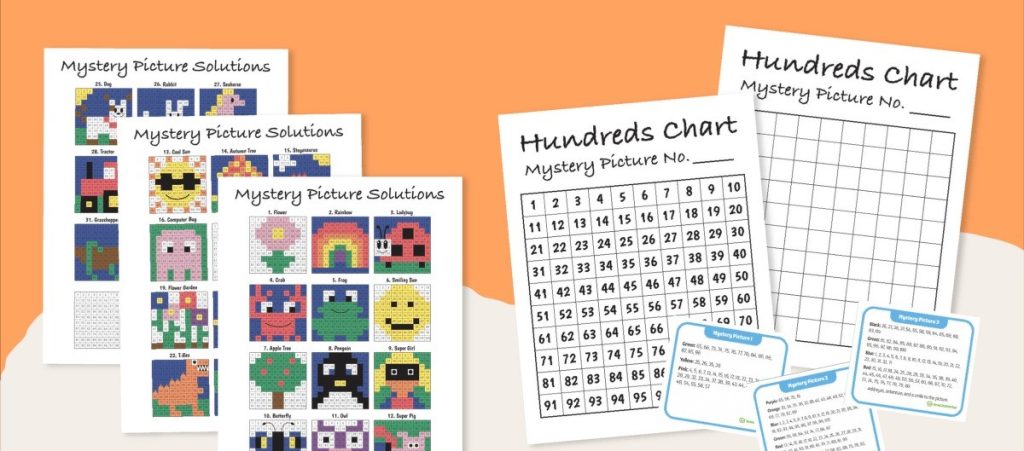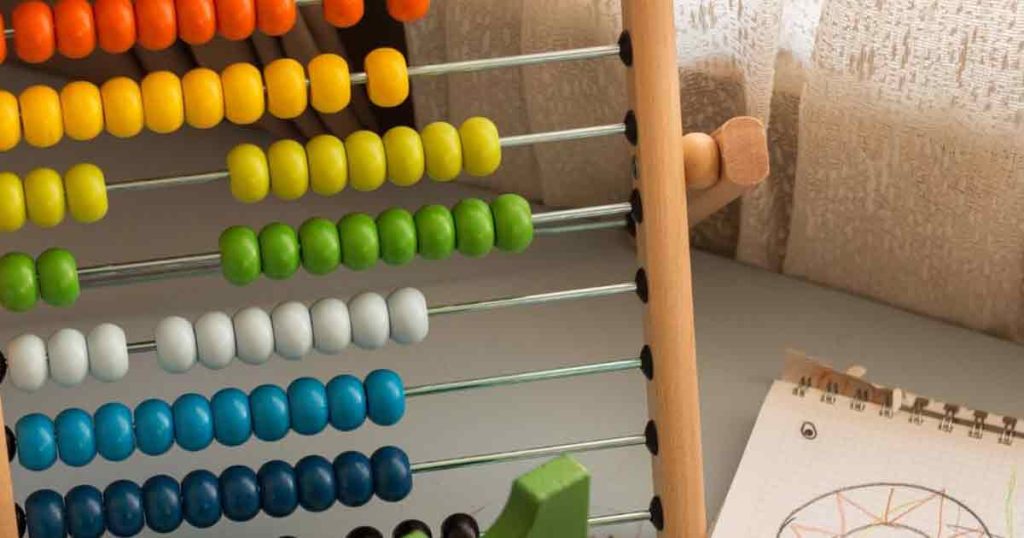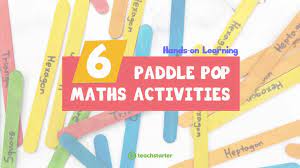Connecting mathematics to fun and practical applications can make it a favorite subject among students. Empower young learners with these four quick and easy math tricks that are perfect for the classroom environment:
1. Multiplication by 11: To quickly multiply any two-digit number by 11, simply add the two digits of the original number together and place the sum in between them. For instance, to multiply 34 by 11, you add 3 + 4 to get 7, then place the 7 between the 3 and the 4 to get 374.
2. The Nine Times Finger Trick: For multiplication problems involving nine, students can use their fingers to find the answer. Have them spread out all ten fingers and lower the finger corresponding to the number they’re multiplying by nine (for example, for 9 x 3, lower the third finger). The number of fingers to the left of the lowered one represents tens, and to the right are ones.
3. Fast Addition with Round Numbers: Teach students to round numbers up or down to make them easier to add quickly in their heads. For example, when adding 456 + 298, it’s easier first to adjust 298 up to 300 (adding 2), then add this to 456 (to get 756), then subtract those extra 2 you added at the beginning.
4. The Magic of Number 5: When multiplying an even number by five, simply halve the number and put a zero at the end. For odd numbers, subtract one from that number before halving it and then append ‘5’ at the end instead of ‘0’. For example, to multiply 6 by five, half of six is three, so just add a zero for your answer of 30; while multiplying five with nine (an odd number), reduce it first to eight, half is four, so your answer is forty-five.
Incorporating these math tricks into classroom activities not only makes learning fun but also enhances mental calculation skills for students of all ages.
Four Operations Games and Puzzles
Mathematics forms an integral part of educational curriculums around the world, establishing a foundation for critical thinking and problem-solving skills that students will carry forward into adulthood. Among the most essential elements of early mathematics education are the four operations: addition, subtraction, multiplication, and division. Games and puzzles designed around these operations not only enhance learning but also engage students in a fun and interactive way. This article delves into the importance of four operations games and puzzles in early math education.
At the core of these educational tools is the aim to make abstract concepts tangible. By using games that incorporate counting, combining, separating, equal groups, and sharing, children can physically manipulate objects or solve problems that represent mathematical theories in real-world contexts. Puzzles featuring mathematical operations challenge students to apply what they’ve learned in new and unique scenarios, ensuring a deeper understanding of the material.
One prime example is math board games that require players to use addition or subtraction as they progress along. These games often introduce a competitive edge that encourages repeated practice without the monotony that can come with traditional worksheets or flashcards. “Math Bingo,” for instance, promotes quick recall of basic operation facts, bolstering mental math skills.
Another effective tool is the use of card games such as “Math War” where players flip cards and perform an operation based on what’s drawn. These types of games support cognitive flexibility as children must quickly switch between different operations based on game rules.
Puzzles contribute to this learning environment by presenting challenges that often have one correct solution but several methods to arrive there. By engaging with puzzles like Sudoku or KenKen, which are built on principles of arithmetic operations and logic, students not only practice their math skills but also improve their reasoning and problem-solving abilities.
Moreover, puzzles serve an important role in differentiating instruction. They can be tailored to varying levels of difficulty to meet individual learner needs. Puzzle-based assignments allow stronger students to delve deeper into complexity while providing foundational practice for those needing more support.
Interactive apps take four-operation learning further by adding a layer of technology that resonates with today’s digitally native students. These apps can adapt in real-time to a child’s ability level, keeping them challenged just enough to stay engaged without becoming frustrated. Tools like “Prodigy” and “DragonBox” are prominent examples where game-based learning meets curriculum standards.
In conclusion, four operations games and puzzles offer a unique blend of entertainment and education which is critical in maintaining student engagement and supporting differentiated learning needs. They provide a practical approach where learners actively construct their mathematical knowledge through play. This method enables students to build confidence in their abilities while fostering a positive attitude toward mathematics—a crucial factor in ongoing academic success. As educational trends continue to evolve, integrating four operations games and puzzles into learning experiences remains an innovative strategy for enriching early mathematics education.
Composite Numbers
Composite numbers are integers that have more than two distinct positive divisors. This means they can be divided evenly by numbers other than one and themselves. Contrary to prime numbers, which can only be divided by one and the number itself, composite numbers have at least one additional divisor.
The number 4 is an example of a composite number because in addition to being divisible by 1 and 4, it can also be divided by 2. Similarly, the number 6 is a composite number because it has four positive divisors: 1, 2, 3, and 6.
To understand composite numbers better, it’s important to clarify what factors are. Factors of a number are integers that can be multiplied together to produce that number. For instance, if we take the number 12, its factors are 1, 2, 3, 4, 6, and 12. Since there are more than two factors in this list, we identify it as a composite number.
Identifying a composite number is straightforward; any integer greater than one that is not prime is considered composite. However, the differentiation of these numbers continues beyond their definition. Just as we classify prime numbers into different types like twin primes or Mersenne primes, there are also different kinds of composite numbers:
1. Square Numbers: These are composites which can be represented as the square of an integer. For example, 9 (which is 3 x 3) and 16 (which is 4 x 4).
2. Cubed Numbers: These are composites that result from an integer being raised to the power of three. An example would be the number 27 which is equal to \(3^3\).
3. Powerful Numbers: A positive integer is powerful if every prime factor occurs twice or more in its prime factorization. For example, the number \(72\) (which has a prime factorization of \(2^33^2\)), is powerful since both prime factors \(2\) and \(3\) appear squared.
Composite numbers play a critical role in mathematics and its various branches like number theory and abstract algebra. They are also foundational elements in cryptography — particularly RSA encryption — where large composite numbers derived from two priming factors create secure cryptographic keys.
Understanding how composite numbers work helps us gain deeper insight into how integers can be broken down into fundamental building blocks — primes — and reassembled in various ways to create new numbers. It’s through these building blocks that we can explore the realm of mathematics further while applying these concepts to practical situations such as coding theory and internet security protocols.
Fact Families Teaching Resources
Understanding the relationships between numbers is a fundamental aspect of learning mathematics. A ‘fact family’ is a group of related mathematical facts that involve the same set of numbers. In essence, if you know one fact within a family, you can understand others by using basic arithmetic operations like addition and subtraction, or multiplication and division. Fact families are commonly used in primary education to help students recognize these relationships and develop fluency in their mathematical operations.
Teaching resources for fact families typically include colorful charts, engaging worksheets, interactive games, and hands-on activities that assist in making the concept understandable and fun. Educators often employ puzzles that require students to find missing members of a fact family, reinforcing the connections between numbers in a tactile way.
Printable worksheets are particularly widespread as they can be used both in the classroom and as homework assignments. These worksheets often have different sections; some focus on the conceptual understanding while others provide practice drills to enhance speed and accuracy in calculations.
Games are another fantastic tool in teaching fact families. These can range from simple card games where students match different parts of a fact family to more sophisticated digital games that adapt to a student’s level of understanding, providing immediate feedback and progressively challenging tasks.
Teachers also use story-based activities where students create their own stories using given numbers from fact families. This has been shown to help with retention as it adds a narrative element to what might otherwise be rote memorization.
Educators continually seek out innovative teaching resources that engage children with fact families. Several educational websites offer a multitude of resources aligned with curricular standards which teachers can incorporate into their lesson plans. Manipulatives like number tiles or dice can also be integrated into lessons, providing a kinesthetic element to learning fact families.
Professional development workshops on the topic often provide teachers with additional methodologies and tools for presenting fact families effectively, demonstrating how these resources can be tailored to diverse learning environments and student needs.
In summary, teaching resources for fact families cater to a wide range of activities designed to facilitate an understanding of numeric relationships through practice, play, visual aids, and creative storytelling. Teachers leverage these resources to ensure that students grasp this critical mathematical concept which forms the foundation for further studies in mathematics.
Pirates on a Number Line – Number Location Interactive Activity
The engaging and educational game “Pirates on a Number Line” offers a swashbuckling approach to teaching kids number placement and recognition on a number line. This interactive activity is designed to capture the imagination of young learners, making math fun and accessible.
In this activity, children will help pirates find treasures by placing them at the correct position on a number line. Each treasure is marked with a number, and players must use their understanding of numerical order to place the treasure in the correct spot. This game can include whole numbers, fractions, or decimals depending on the difficulty level.
“Pirates on a Number Line” is not only enjoyable but also educational. It aids children in grasping the concept of number magnitude and understanding how numbers relate to one another and their positions on the number line. As the levels progress, the challenges become more complex, involving larger numbers and smaller intervals.
Teachers and parents alike appreciate this game for its dual role in education and play. Children love it because it brings an element of adventure to learning math—a subject that can sometimes be intimidating or dull for some students.
This interactive activity is usually available on educational websites or as part of a classroom digital suite. It’s equipped with colorful graphics, engaging sound effects, and various levels to keep students motivated and excited about their learning journey through mathematics.
Playing “Pirates on a Number Line” allows kids to improve their mathematical skills while embarking on a thrilling pirate adventure—because who says learning can’t be an adventure?
32 Awesome Hundreds Board Mystery Picture Task Cards!
Hundreds Board Mystery Picture Task Cards are the latest engaging educational tool that teachers and parents are raving about! These innovative cards bring a touch of excitement and intrigue to mathematics learning, particularly when it comes to understanding numbers and honing counting skills. Ideal for children in kindergarten through second grade, the mystery picture cards provide a unique hands-on experience that combines critical thinking with fun.
So, what makes the set of 32 Awesome Hundreds Board Mystery Picture Task Cards so special? Each card features a series of clues or instructions that lead students to color certain squares on a hundreds chart. As they follow the directions, a surprise picture begins to emerge. This adds an element of discovery and delight to their numerical explorations, turning an ordinary lesson into an extraordinary adventure.
The variety found within these 32 cards ensures that there’s always a new challenge to be tackled. Teachers can use them in math centers, for individual practice, or even as part of a collaborative activity where teamwork can lead to uncovering the hidden image. They align wonderfully with common core standards for mathematics, reinforcing concepts like number recognition, sequencing, and one-to-one correspondence.
Beyond academic growth, these task cards foster problem-solving skills and attention to detail. Children become mini detectives, looking for patterns and making predictions about what the final image might be as they decode each clue. The excitement is palpable in classrooms where these task cards are introduced!
Moreover, these task cards are incredibly versatile – whether used as a warm-up exercise at the start of class, a transition between lessons, or as a reward for work well done – they always seem to fit seamlessly into the classroom routine.
The 32 awesome task cards also cater to different learning styles. Visual learners, in particular, will appreciate the graphical nature of filling in a hundreds chart to reveal an image. However, kinesthetic learners will also benefit from the hands-on nature of coloring specific squares; while logical-mathematical learners will enjoy deducing the correct squares through problem-solving.
To make it even more convenient for today’s educators, these hundreds board mystery picture task cards often come with detailed instructions and suggestions for use. Some sets also include answer sheets for self-checking by students or simple assessment by teachers.
These brilliant task cards don’t just aid learning in isolation; they can also enhance communication skills as students eagerly discuss their findings with peers or explain their strategies during share-and-tell moments.
In conclusion, bringing 32 Awesome Hundreds Board Mystery Picture Task Cards into your educational repertoire could revolutionize how students engage with numbers. They’re not only an effective learning resource but also inject fun into math practice — ensuring that children associate positive emotions with their numerical journey. These task cards prove that when education gets creative, students not only learn — they thrive!
22 Maths Mental Game Ideas and Resources
1. Speed Math Duel – A game where two players race to solve as many math problems as possible within a set time limit.
2. Times Table Bingo – Practice multiplication tables with bingo cards and a fun, competitive twist.
3. Fraction War – A card game where players compare fractions to capture cards from their opponents.
4. Math Jeopardy – Create a Jeopardy-style board with varying difficulties of math questions for an engaging classroom review game.
5. Math Puzzles – Offer students a variety of puzzles that involve mathematical reasoning, such as Sudoku or KenKen.
6. Math Board Games – Incorporate classic board games with a maths twist, like Math Scrabble where each letter has a numerical value.
7. Number Memory Match – Enhance memory skills while practicing number recognition with a math-themed memory card game.
8. Online Math Challenge Websites – Websites such as IXL or Khan Academy offer interactive math challenges for all grade levels.
9. Escape Room Challenges – Design math-themed escape room scenarios that require solving problems to “escape” the classroom or virtual space.
10. Interactive Whiteboard Games – Use technology to create interactive games for the whole class on a smartboard or tablet.
11. Geometry Scavenger Hunt – Have students find and photograph real-world examples of geometric concepts like different types of angles or shapes.
12. Estimate and Measure Races – Compete to estimate and then measure different objects around the school or home to see who is most accurate.
13. Graphing Relay Races – Turn graphing exercises into a physical activity by having teams race to plot points correctly on a large coordinate plane.
14. Money Management Game – Set up a mock store and currency to teach practical math skills related to money management and budgeting.
15. Probability Fair – Set up stations with different probability games like coin tosses, dice rolling, or spinner activities.
16. Real-Life Word Problems – Craft story problems based on real-life situations that require mathematical solutions.
17. Pattern Block Puzzles – Challenge students with creating specific designs using only certain shapes and sizes of pattern blocks.
18. Math Triathlon – Organize an event where students compete in multiple math-related activities, combining physical challenges with problem-solving tasks.
19. Flashcard Challenge – Use flashcards for quick-fire rounds of practice on any mathematical operation or concept; try to beat personal bests or peer scores.
20. Cooking With Fractions – Bake or cook something in class or at home requiring fraction measurements for a tasty lesson in applied mathematics.
21. Treasure Hunt Game – Hide ‘treasure’ along with math problems that need to be solved to move closer to the prize, encouraging both critical thinking and movement throughout the space.
22. DIY Math Videos – Encourage students to make their own short videos explaining math concepts or solving problems, fostering creativity along with subject mastery.
Remember, these games should be tailored according to age groups and difficulty levels to meet educational needs while ensuring they remain engaging and fun for all participants!
6 Paddle Pop Maths Activities for Hands-on Learning
Maths can be a challenging subject for some students, especially when it does not involve any practical activities. Fortunately, with a little creativity and some paddle pop sticks, maths can become a fun, hands-on learning experience. Let’s explore six engaging paddle pop stick maths activities designed to make learning both fun and educational.
1. Counting and Sorting
Encourage children to use paddle pop sticks for counting and sorting exercises. Start by giving them a specific number of sticks and ask them to sort them into groups of two, five, or ten. This activity is perfect for teaching basic counting skills and understanding multiples.
2. Building Shapes
Paddle pop sticks can be easily used to construct different geometric shapes. Children can create triangles, squares, rectangles, and other more complex polygons by laying out sticks on a flat surface. This activity helps with the recognition of geometric shapes and understanding the properties of each figure.
3. Addition and Subtraction Tower
Create a tower building game where each addition or subtraction answer represents the number of paddle pop sticks used to build the next level of the tower. For example, if the math problem is 3+2, they would add five sticks to create the next layer. This visual representation helps to reinforce basic arithmetic skills.
4. Fractions Fun
Introduce fractions by grouping paddle pop sticks together and then dividing them into halves, thirds, or quarters. Showing children how to break down groups into smaller parts provides a clear visual of how fractions are formed and what they represent.
5. Paddle Pop Graphs
Use paddle pop sticks to create bar graphs on a piece of paper or cardboard. Children can learn about data collection and interpretation by measuring and comparing the height of each “bar” in their graph. This activity makes understanding graphs interactive and tangible.
6. Measurement Practice
Paddle pop sticks can also serve as makeshift rulers for measuring items around the classroom or home. This hands-on activity teaches children about length and reinforces units of measurement like inches or centimeters.
Each activity not only supports vital mathematical concepts but also encourages fine motor skill development as children manipulate the paddle pop sticks into various formations. Using tangible items like paddle pops in maths provides an engaging way for children to explore numerical concepts while having fun.
Fact Family Fun!
Math can be a daunting subject for young learners. However, with the concept of fact families in arithmetic, math can become an enjoyable and engaging activity that helps students understand the relationship between addition and subtraction, or multiplication and division. Let’s take a fun dive into the world of fact families!
What are Fact Families?
A fact family is a group of related math facts that use the same set of numbers. In addition and subtraction fact families, there are three numbers involved, which relate to each other through four math facts — two addition facts and their corresponding subtraction facts. For multiplication and division fact families, these numbers are related through two multiplication facts and two division facts.
Understanding Fact Families
Consider the numbers 7, 5, and 12. They form a fact family because:
– If you add 7 and 5, you get 12 (7 + 5 = 12).
– If you add 5 and 7, you still get 12 (5 + 7 = 12). This demonstrates the commutative property of addition.
– If you start with 12 and take away 7, you’re left with 5 (12 – 7 = 5).
– If you start with 12 and take away 5, you’re left with 7 (12 – 5 = 7).
As for multiplication and division, let’s look at the numbers 6, 4, and 24:
– Multiplying 6 by 4 gives us our product, which is 24 (6 x 4 = 24).
– Multiplying these numbers in any order will give us the same product (4 x 6 =24).
– Dividing our product by one factor gives us the other factor (24 ÷ 6 =4).
– Similarly, dividing our product by the other factor gives us our remaining factor (24 ÷4 =6).
Why are Fact Families Important?
Fact families are crucial in building a student’s number sense because they demonstrate how numbers are interconnected. Grasping this concept helps children develop strategies for problem-solving that go beyond mere memorization of math facts.
Here’s how they make math fun:
– Through playing games that incorporate creating different fact families.
– By using manipulatives like blocks or beads to visualize and create real-world connections to mathematical concepts.
– Students can create posters or “family trees” for their fact families.
In conclusion, fact family fun is not only an educational concept but also a delightful way to promote confidence in mathematics. By integrating this approach within learning activities, kids can discover a newfound love for numbers that can last for many years. Let’s make learning math an adventure filled with discovery!
Fact Family Find and Flip – A Fun Way to Master Basic Math Skills
Mathematics is a fundamental subject that forms the basis for many educational pathways. As such, it is critical that students attain a strong grasp of basic arithmetic operations early on to set the foundation for more complex math concepts. This is where games like Fact Family Find and Flip come into play, particularly for practicing addition and subtraction up to 20.
Fact Family Find and Flip is an engaging educational game designed to help children understand the relationship between addition and subtraction through fact families. A fact family consists of three numbers that are closely related, just like members of a family. Within this trio, two smaller numbers add up to the larger one, and conversely, the larger number can subtract either of the smaller ones to find the other.
For instance, if we take the numbers 7, 8, and 15 – they make up a fact family. This is because 7 + 8 = 15, while 15 – 7 = 8 and 15 – 8 = 7. Finding these relationships between numbers helps children comprehend that addition and subtraction are inverse operations.
The Fact Family Find and Flip game typically includes a set of cards or tiles with numbers on one side. The task is for students to identify the three numbers that form a valid fact family and then ‘flip’ these cards over to reveal a picture or pattern on the reverse side as a reward for solving. The game usually comes with several sets of these three-card groups, allowing extensive practice with different numbers.
What makes Fact Family Find and Flip particularly beneficial is its hands-on approach to learning. Children can physically manipulate the cards, pairing different numbers together until they find the correct combination that fits into a fact family structure. This tactile engagement not only makes learning fun but also enhances memory retention.
Teachers and parents find Fact Family Find and Flip to be an excellent tool for lessons or practice sessions because it encourages children’s independent learning through play. As students work with tangible objects to sort out mathematical relationships on their own or in small groups, they develop problem-solving skills and build confidence in their math abilities.
The rules of Fact Family Find and Flip are simple enough to be understood by students who are beginning to learn addition and subtraction, making it suitable for classroom environments or at-home learning for young learners aged around five to seven years old.
In conclusion, Fact Family Find and Flip offers an innovative approach to teaching children about the interconnectedness of addition and subtraction up to the number 20. By incorporating fun into fundamental math education, it empowers students with a better understanding of number relationships while fostering enthusiastic participation in learning activities. With such playful educational tools at their disposal, parents and educators can ensure that kids develop a lasting appreciation for mathematics right from their early years.
